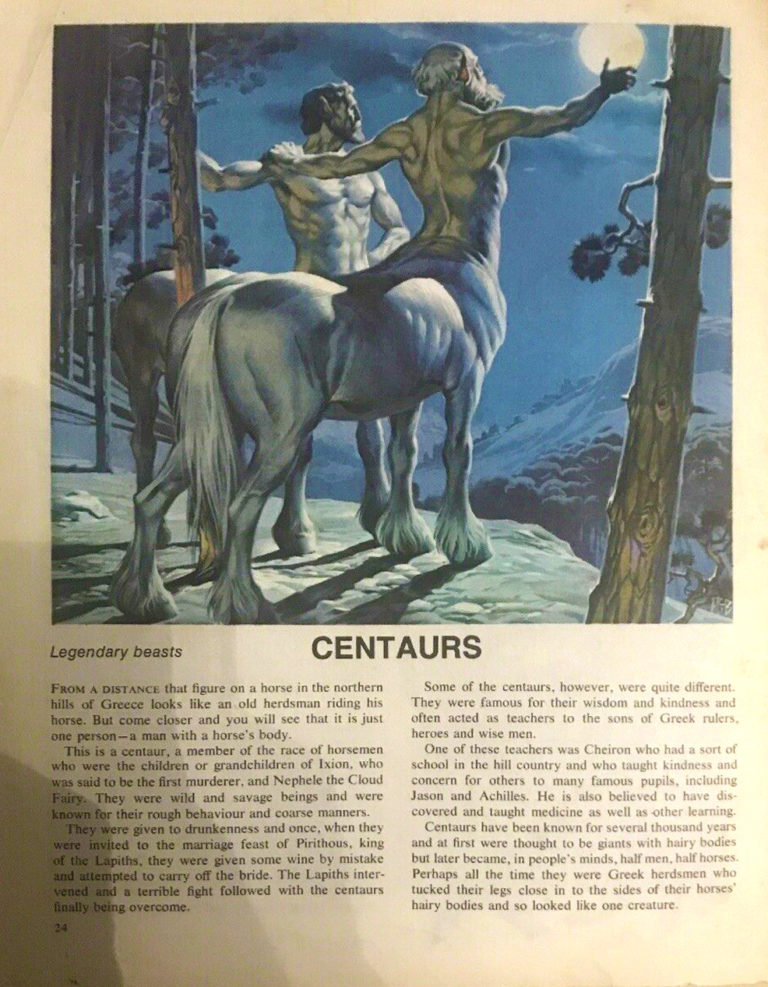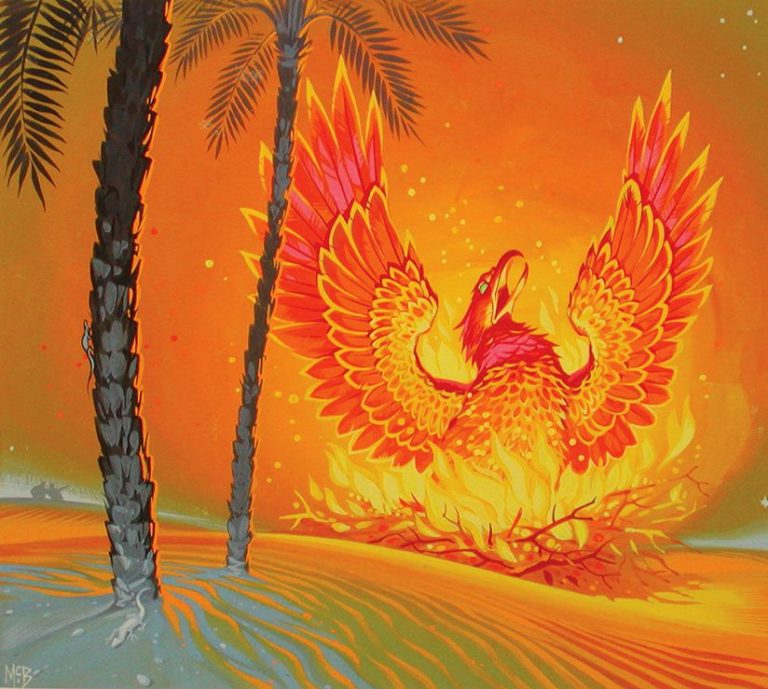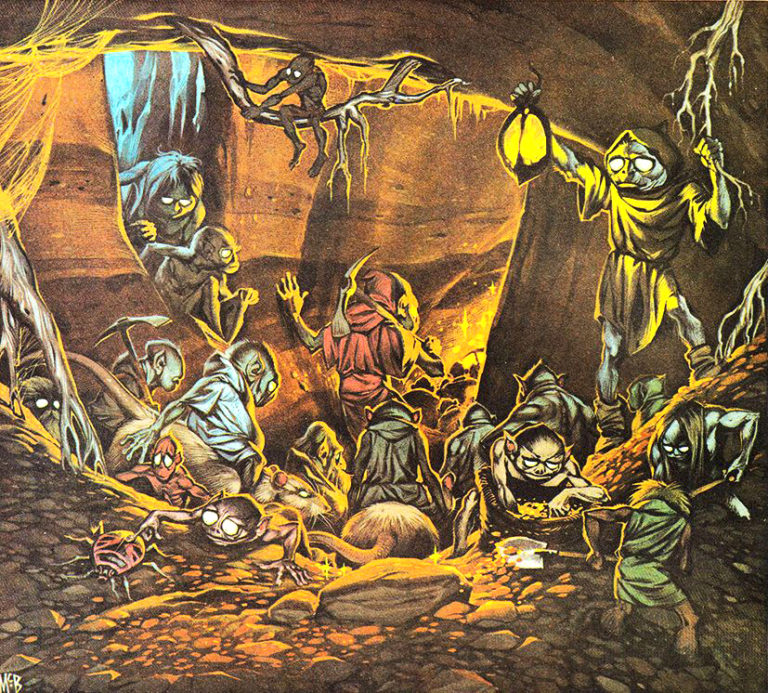Angus McBride’s Legendary Beasts
Published by Daisy on
Collecting » Myths, Legends, Folklore » McBride’s Legendary Beasts
Andrew McBride's Legendary Beasts
Whilst undertaking my research of the Grahame Johnstone twins‘ series illustrations in the Finding Out magazines, I came across another fantastically illustrated series called “Legendary Beasts” by historical and fantasy artist Angus McBride. These one-page articles (half full-colour illustration, half descriptive text) appeared on the back of the weekly Finding Out magazines in 1966, and the series included 36 legendary animals in all.
I was fascinated enough by his lush artworks (and my own long-term obsession with cryptozoology) to hunt down all of the original illustrations along with many of the original articles. Which now I share with you, dear reader, along with snippets about the legendary beasts he depicted – I hope you enjoy them! Click on the images to embiggen if you want them in their full glory…
Unicorns – Finding Out Vol 15 No 12
A unicorn is a horse-like beast with a single large, pointed, spiraling horn projecting from its forehead. Unicorns are found in many stories and myths from different parts of the world, especially China and India. Its blood and horn usually have mystical powers. In Western culture, its horn (‘alicorn’) is said to have the power to heal wounds and sickness, and to neutralize poison, and it symbolizes innocence, purity and feminine power.
Mermaids – Finding Out Vol 16 No 1
“Another victim has been claimed by the mermaids. They have lured this man’s ship on to the rocks and wrecked it, and when the poor man is washed up on shore his flesh will be eaten down to the bone by the mermaids.”
A mermaid is an aquatic creature with the head and upper body of a woman and the tail of a fish. Also known as sirens.
Gryphons – Finding Out Vol 16 No 2
“The gryphon, sometimes known as the griffin or griffon, is perhaps the most famous creature of its kind in the mythology of Europe and western Asia.”
This noble creature has the head, wings and front legs of an eagle, and the body and back feet of a lion. It has been described as the guardian of great treasures.
Sea Serpents – Finding Out Vol 16 No 3
“The sea serpent owes its origin to traveller’s tales – perhaps it was dolphins playing, a giant squid from northern seas, a plesiosaurus from the depths of the ocean, two sharks basking in the sun, or even sea-weed massed together, which the traveller saw and thought to be a serpent.”
Sea serpents are referred to as ‘kings’ of the ocean. In Norse mythology, Jörmungandr, or “Midgarðsormr” was a sea serpent so long that it encircled the entire world.
The Phoenix – Finding Out Vol 16 No 4
“Every five hundred years – some think it was only every 12 thousand years – the phoenix returned to the Egyptian desert to die in a fire of its own making. It made a next of twigs from the spice tree, then set the nest on fire and burned itself alive.”
Associated with the Sun, a phoenix is reborn by arising from the ashes of its predecessor.
Harpies – Finding Out Vol 16 No 5
“The Greek word harpyiai means ‘snatchers’ and this is the best way to describe the harpies, those horrible creates of Greek stories that were said to look like birds and have the faces of women.”
In Greek and Roman mythology, a harpy was a half-human and half-bird personification of storm winds in Homeric poems.
Satyrs – Finding Out Vol 16 No 6
“The satyrs in our picture look a cheerful lot. Maybe they were on their way to one of Bacchus’s feasts. For satyrs, in classical myth, were usually to be found at the revels of Bacchus – the god of wine – and his fun-loving friends.”
A satyr (also known as silenos) is a male nature spirit with ears and a tail resembling those of a horse.
The Wild Hunt – Finding Out Vol 16 No 8
“On wild, dark, stormy nights, when the thunder crashes and the wind howls, have you ever thought that you heard the baying of ghostly hounds, and the thunder of the hooves of a phantom horse?”
Wild Hunts typically involve a ghostly or supernatural group of hunters with wild demon dogs racing in wild pursuit. The hunters may be either elves or fairies or the dead. The hounds are known by other names such as as barguest, padfoots, wish-hounds or yegh-hounds.
Hippocamps – Finding Out Vol 16 No 9
“On a rough day, if you look out to sea, the great white waves riding towards the shore often seem to be herds of angry, galloping horses.”
The hippocampus, also known as a sea-horse, is typically depicted as having the upper body of a horse with the lower body of a fish. Hippocampi were used by Neptune, god of water, to draw his shell-shaped chariot.
The Cailleach-Bheur – Finding Out Vol 17 No 2
“When summer comes to the islands off the coasts of Northern Scotland, the fishermen remember the story of how the old Celtic mother goddess, Cailleach-Bheur, chased her son round the islands when he rode away on a horse with the girl he wanted to marry.”
In Gaelic mythology, the Cailleach is a divine hag, a creator deity, a weather deity, and an ancestor deity. She carried a hammer, and is also commonly known as the Cailleach Bhéara(ch) or Bheur(ach), and also as Beira, Queen of Winter. The word literally means “old woman’ or ‘hag'”.
The Midgard Serpent – Finding Out Vol 17 No 3
In Norse mythology, Jörmungandr (meaning “huge monster”), is a sea serpent also known as the Midgard (World) Serpent (Miðgarðsormr). The Midgard Serpent is the middle child of the giantess Angrboða and Loki, who was thrown into the great ocean that encircles Midgard by Odin. The serpent grew so large that it was able to surround the earth and grasp its own tail.
The Morrigan – Finding Out Vol 17 No 4
“Long, long ago, when there was constant fighting between the Celtic kingdoms of Ireland, the Morrigan was often seen by the battling Irish heroes. Many was the time that, just before a battle, she would appear amongst the warriors in the guise of an old hag, uttering grim prophecies. It was unwise to ignore or to scoff at her, for she could make sure that the battle went against that man or his side.”
When inciting warriors to battle, the Morrigan often appears as a crow, the badb.

Werewolves – Finding Out Vol 17 No 5
A werewolf (or lycanthrope) is a human with the ability to shape-shift into a wolf, either purposely or after being placed under a curse or affliction (often a bite or scratch from another werewolf) and especially on the night of a full moon.
Thunderbird – Finding Out Vol 17 No 6
“To the Indians of the north-west, that Thunderbird was an ‘airy spirit’, half-way between man and true god. He was to be seen carved into tribal history as it appeared on many Indian totem poles, and also in various forms on shield, masks and sacred rattles.”
In Algonquian mythology, the thunderbird controls the upper world and throws lightning at the underworld creatures and creates thunder by flapping its wings. Thunderbirds in this tradition are commonly depicted as having an X-shaped appearance.


Centaurs – Finding Out Vol 17 No 7
“From a distance that figure on a horse in the northern hills of Greece looks like an old herdsman riding his horse. But come closer and you will see that it is just one person – a man with a horse’s body. This is a centaur, a member of the race of horsemen who were the children or grandchildren of Ixion, who was said to be the first murderer, and Nephele the Cloud Fairy.”
Centaurs are thought of in many Greek myths as being as wild as untamed horses.
Sphinxes – Finding Out Vol 17 No 11
A sphinx is a mythical creature with the head of a human and the body of a lion. It is mythicised as treacherous and merciless. Those who cannot answer its riddle suffer a fate typical in such mythological stories, as they are killed and eaten by this ravenous monster.
Cyclopses – Finding Out Vol 17 No 12
A cyclops, in Greek mythology and later Roman mythology, is a member of a primordial race of giants, each with a single eye in the centre of his forehead. Hesiod described three one-eyed cyclopes who served as builders, blacksmiths, metalworkers, and craftsmen, which is the scene depicted here.
Paul Bunyan and Babe – Finding Out Vol 18 No 1
“Sitting around their flickering campfires, surrounded by the vast lonely timberlands of North America, early woodsmen found their only entertainment in story telling. Their favourite hero was the mighty lumberjack, Paul Bunyan, who, they say, invented logging.”
His exploits revolve around the tall tales of his superhuman labours, and he is customarily accompanied by Babe the Blue Ox.
Chinese Dragons – Finding Out Vol 18 No 2
“The Chinese dragon is regarded as a bringer of prosperity. He was used as a symbol of royalty and power in the ancient Chinese civilization. An imperial dragon, as this one is, has five claws. Lesser dragons have four or sometimes only three claws.”
The Chinese writer, Wang Fu, described a Chinese dragon thus: ‘His horns resemble those of a stag, his head that of a snake, his belly that of a clam, his scales those of a carp, his claws those of an eagle, his soles those of a tiger, his ears those of a cow.'”
The Minotaur – Finding Out Vol 18 No 3
“When the wife of King Minos of Crete had a son who grew up to be half man, half bull, the king was ashamed and hid his son, the Minotaur, away.”
The Minotaur dwelt at the centre of the Labyrinth, an elaborate maze-like construction designed by the architect Daedalus and his son Icarus, on the command of King Minos of Crete. The Minotaur was eventually killed by the Athenian hero Theseus.
Huitzilopochtli – Finding Out Vol 18 No 4
In the Aztec religion, Huitzilopochtli is a deity of war, sun and human sacrifice. Huitzilopochtli is seen as the sun in Aztec mythology, while his many male siblings are perceived as the stars and his sister as the moon. This is the reason why the Sun is constantly chasing the Moon and stars.
Ammit – Finding Out Vol 18 No 5
Ammit (also known as Ammut or Ahemait) was a demoness and goddess in ancient Egyptian religion with a body that was part lion, hippopotamus, and crocodile. This image features the weighing of the heart ceremony in Duat, the Egyptian underworld. In the Hall of Two Truths, Anubis weighed the heart of a person against the feather of Ma’at, the goddess of truth, which was depicted as an ostrich feather. If the heart was judged to be not pure, Ammit would devour it, and the person undergoing judgement was not allowed to continue their voyage towards Osiris and immortality.
Domovoi – Finding Out Vol 18 No 8
A domovoy is a Russian household god. Sometimes he has a female counterpart, Domania, the goddess of the household, though he is most often a single god. The Domovoy expresses himself as a number of other spirits of the household in its different functions. They are very protective towards the children and the animals of the house.



















































2 Comments